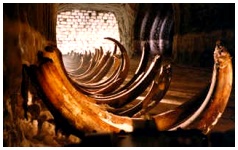
 Mammoth Graveyard Although Great Woolly Mammoths were well adapted to survive in the frigid Arctic, they nevertheless became extinct around 10,000 years ago following the end of the Ice Age. Living south of the ice sheets, they roamed the treeless landscape of rich, grassy vegetation all the way from Siberia to eastern North America. Mammoths were relatively abundant. Their remains left behind so much ivory in Northern Asia that a trade in fossil mammoth tusks began in the Middle Ages and is still ongoing today in Russia. The great ivory tusks were curved and very long - those of the largest males could be up to 15½ feet / 4.8 meters long! Their curved shape and size indicate that they would have been used to uncover vegetation buried in the snow. A storage cave in the Russian city of Khatanga, inside the Arctic Circle, is used to store ivory and other mammoth remains found on the Siberian Taymyr Penninsula. The cave is maintained at a dry and cold -12°C / 10°F. (Picture)
Click pictures for more information and credits. Library: Arctic, Land Animals, Eurasia Links: Arctic, Animals, Ice Age Arctic Maps & Weather Reports News Story: "They Live - AGAIN!" |

|
DICTIONARY: Just "double-click" any unlinked word on this page for the definition from Merriam-Webster's Student Electronic Dictionary at Word Central. |

|
ARCTIC LIBRARY & GLOSSARY: Check this section for an index of the rest of the things you really need to know about the Arctic. |

|
ARCTIC MAPS & WEATHER REPORTS: Maps of the Northwest Passage, explorers' routes, iceberg sources, Nunavut, the Arctic by treeline, temperature... |

|
ARCTIC LINKS: Even more information! Links to sites related to the Arctic and "Iceberg: the Story of the Throps and the Squallhoots". |

|
GUIDE TO ARCTIC SUNRISE & SUNSET: How much sunlight or darkness is there in the Arctic on each day of the year? |
to is the property of their respective owners, and Athropolis is not responsible for their content.